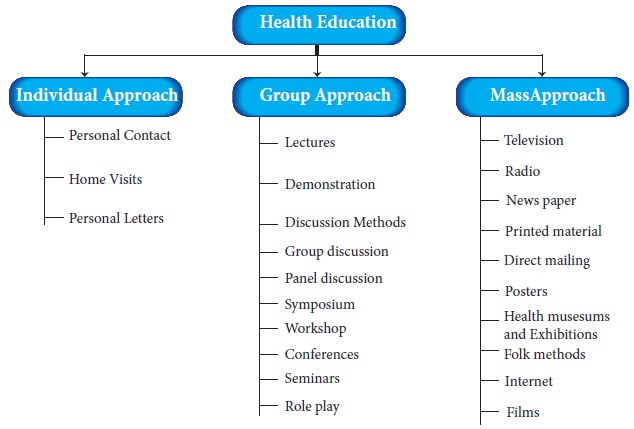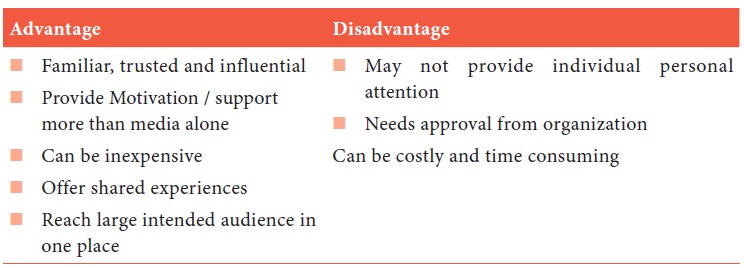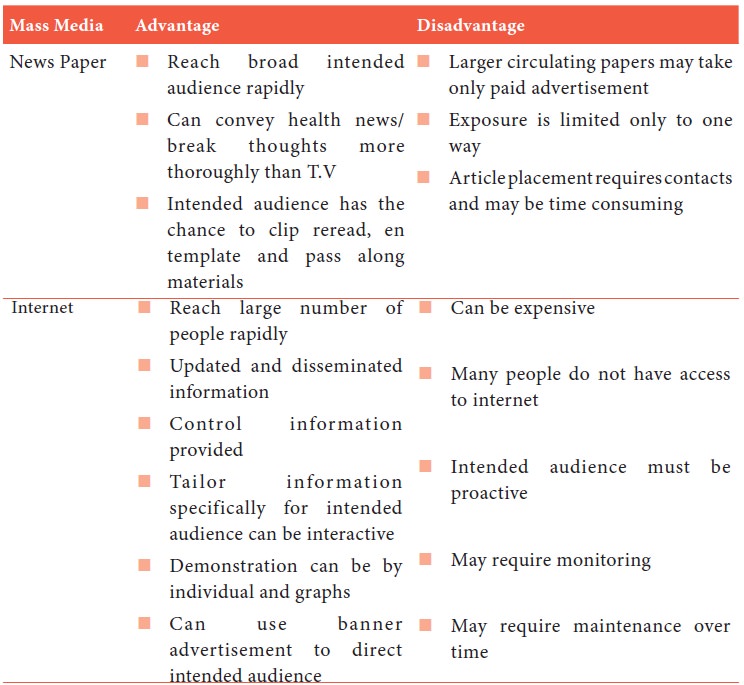Chapter: 11th Nursing : Chapter 10 : Health Education and Audio visual Aids
Methods & Approaches of Health Education
Methods & Approaches of Health Education

Methods of health education
Health education is carried
out at 3 main levels;
·
Individual Approach.
·
Group Approach.
·
General Approach/Mass.
Individual Health Education:
Doctors and nurses,
who are in direct contact with patients and their relatives, have opportunities
for much individual health education. The topic selected should be relevant to
the situation. For instance, a mother who has come for delivery should be told
about child birth-not about malaria eradication.
The biggest advantage
of individual health teaching is that we can discuss, argue and persuade the
individual to change his behaviour. The disadvantage is that the numbers we
reach are small.
Group Health Education:
The groups are many –
mothers, school children, patients, industrial workers – to whom we can direct
health teaching. The choice of subject in group health teaching is very
important; it must relate directly to the interest of the group. For instance,
mothers may be taught about baby care; school children about oral hygiene; a
group of TB patients about tuberculosis, and industrial workers about
accidents.
Methods of Group Teaching
These have been
classified as below:
One – way or didactic
methods:
·
Lecture
·
Films
·
Charts
·
Flannel graph
·
Exhibits
·
Flashcards
1. Lectures:
Lectures are the most popular method of health
teaching. In this, communication is mostly one-way, i.e., the people are only
passive listeners; there is no active participation on their part in learning.
How impressive and effective the lecture is, depends upon the personality and
reputation of the speaker. A lecture does provide basic information on the
subject, but it may fail to change the health behaviour of the people.
Nevertheless lectures have an important place in the health education of small
groups.
2. Films, charts & Puppets:
These are mass media of communica-tion. They
can be of value in educat-ing small groups.
Suspense Charts:
Each section of the
charts is covered and is exposed one by one to reveal the story or ideas
without exposing the whole chart at a time.
Puppets:
Puppets are dolls made
by hand and a story can be narrated using them it is a popular teaching aid to
health teaching.
3. Flannel graph:
A flannel graph consists of a wooden board
over which is pasted or fixed a piece of rough flannel cloth or khadi. It
provides an excellent background for displaying cut out pictures and other
illustrations. These illustrations and cut out pictures are provided with a
rough surface at the back by pasting pieces of sand-paper, felt or rough cloth,
and they adhere at once, put on the flannel. Flannel graph is a very chief
medium, easy to transport and promotes thought and criticism. The pictures must
be arranged in proper sequence based on the talk to be given.
4. Exhibits:
These consist of objects, models, specimens,
etc. They convey a specific message to the observer. They are essentially mass
media of communication.
5. Flash Cards:
They consist of a series of cards,
approximately 10 x 12 inches – each with an illustration pertaining to a story
or talk to be given. Each card is “flashed” or displayed before a group as the
talk is in progress. The message on the cards must be brief and to the point.
They are pictures arranged in sequence, which
illustrate a story support the cards in front of the chest and practice in
order to make the teaching effective. Use a Pointer so that the picture is not
covered by your hand.
Two-way or Socratic
Methods:
·
Group discussion
·
Panel Discussion
·
Symposium
·
Workshop
·
Role playing
·
Demonstration
1. Group Discussion:
Group discussion is considered a very
effective method of health teaching. It is a tow-way teaching method. People
learn by exchanging their views and experiences.
·
To be effective, the group should comprise not less than 6, and
not more than 12 people.
·
There should be a group leader who initiates the subject, helps
the discussion in the proper manner, prevents side-conversations, encourages
everyone to participate and sums up the discussion in the end.
·
The proceedings of the group discussion are recorded by a
“recorder”, who prepares a report on the subject and agreements reached.
2. Panel Discussion:
Panel discussion is a novel method of health
education. The success of the panel depends upon the Chairman.
·
The Panel consists of a Chairman or Moderator, and 4 to 8
speakers.
·
The Panel sits and discusses a given problem in front of a group
or audience.
·
The Chairman opens the meeting, welcomes the group and
introduces the panel speakers who are experts on the subject.
·
He introduces the topic briefly and invites the panel speakers
to present their points of view. There are no set speeches, but only informal
discussion among the panel speakers.
·
It is said that the discussion should be spontaneous and
natural.
·
After the subject has been discussed by the panel speakers, the
audience is invited to take part. If properly planned and guided, panel discussion
can be an effective method of health education.
3. Symposium:
A Symposium is a series of speeches on the
selected subject by experts. There is no discussion on the subject by the
experts. In the end, the audience may raise questions and contribute to the Symposium.
4. Workshop:
The Workshop consists of a series of meetings.
The total workshop is divided into small groups, and each group will choose a
Chairman and a recorder. Each group solves a part of the problem with the help
of consultants and resource personnel. Learning takes place in a friendly,
happy and democratic atmosphere under expert guidance.
5. Role Play:
Role Play or socio-drama is a particularly
useful device for putting up problems of human relationship. The group members
enact the roles as they have observed or experienced them, e.g. the expectant
mother in an antenatal clinic, the public health nurse on a home visit, etc.
The size of the group should not be more than 25. Role play is followed by a
discussion of the problem.
6. Demonstrations:
Practicaldemonstrationisanimportant technique
of the health education. We show people how a particular thing is done – using
a tooth-brush, bathing a child, feeding an infant, etc. A demonstration leaves
a visual impression in the minds of the people.
Education of the general public(Mass Approach) :
For the education of the general public, we
employ “mass media of communication’ – Posters, health magazines, films, radio,
television, health exhibitions and health museums. Mass media are generally
less effective in changing human behaviour than individual or group methods.
But however, they are very useful in reaching large numbers of people with whom
otherwise there could be no contact. For effective health education mass media
should be used in combination with other methods.
Individual Approach

Group Approach

Mass Approach


Related Topics